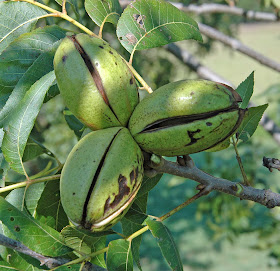After a long winter, Spring finally arrived to the pecan grove. This year, I decided to photograph pecan bud development and leaf burst as it occurred during the month of April. Each week, I snapped photos of pecan shoots on a Kanza tree (protogynous flowering) and a Liberty tree (protandrous flowering).
On April 5th, the buds on Kanza trees had broken open their outer scales and were starting to show swelling green buds (photo at right).
On the same date (April 5) Liberty buds had swollen in size but had yet to split open their outer scales (photo at left).
One week later (April 12) Kanza buds were showing the first stages of leaf burst (photo at right). At this point, the two lateral buds that flank each vegetative shoot are still tightly closed. These lateral buds will eventually produce catkins.
As a protandrous cultivar, Liberty displays its catkins first as buds start to open up in the Spring (photo at left, April 12). The vegetative bud has emerged but leaves have yet to burst forth.
By April 18, Kanza leaves have unfurled and catkins are now visible (photo at right). You should note that Kanza catkins are long and narrow which is typical of catkins produced by protogynous cultivars.
By the same date (18 Apr.), the leaves of Liberty have begun to expand but the catkins are still the dominate feature of this cultivar's new growth. Note that pollen sacs are already quite large on each catkin (photo at left). The short and wide catkins of Liberty are typical of cultivars with a protandrous flowering habit.
One week later (April 25), the new vegetative shoots on Kanza trees have grown 4 to 5 inches in length (photo at right). The extremely long catkins have reached their final length. At this date I could still not detect the formation of a pistillate flower clusters at the apex of new shoot Kanza shoots. Hopefully that will come soon.
On April 25, Liberty leaves have expanded but shoot length lags behind adjacent Kanza trees. However, Liberty catkins are now fully formed and will be ready to shed pollen about the same time as Kanza pistillate flowers appear in early May. (photo at left).
On April 25, I searched long and hard for any signs of pistillate flower formation. After last year's extreme drought, I'm extremely curious to see how my trees will flower this Spring. I did find a single Caney terminal that displayed the early stages of pistillate flower development. In the photo at right, look carefully between the youngest emerging leaves. Note the oval-shaped structure nestled in the shoot's growing tip. That's the first sign of a pistillate flower cluster.




































